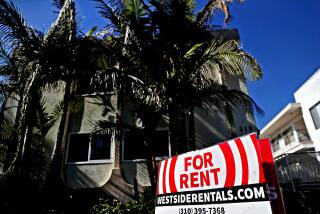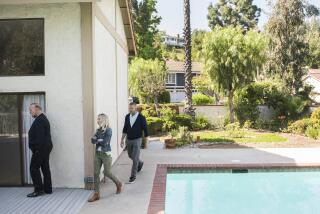Southern California office rents hold steady
Tenants kept the upper hand in office rent negotiations in Southern California in the first quarter, even though conditions improved slightly for landlords as the economy picked up and some businesses expanded.
The most leases were signed in markets such as the Westside and Orange County, where some companies are growing enough to add workers, industry observers said.
“I think we’re on the slow road to recovery,” said Hans Mumper, head of the greater Los Angeles region for real estate brokerage Colliers International. “Leasing activity has been positive.”
Overall vacancy in what are considered “class A” office buildings in Los Angeles, Orange, San Bernardino and Riverside counties averaged 18% in the first quarter, a mild improvement from 19% a year earlier, according to real estate brokerage Cushman & Wakefield.
Average rent in Southern California was $2.31 per square foot a month, up a penny from early 2012.
Vacancy dropped a bit more on the Westside, where thriving technology and entertainment companies have been leading the growth, brokers said. Particularly in demand by such companies is nontraditional “creative space,” which is often found in lavishly renovated former industrial buildings that have been turned into offices.
In Orange County, landlords in its button-down corporate office market signed several leases last quarter, said Joe Vargas, regional manager of Cushman & Wakefield. “They are just having good job growth,” he said. “Orange County has one of the lowest unemployment rates in California.”
Healthcare and professional firms such as investment bankers are among the employment leaders. Tech firm Google Inc. agreed to lease 80,000 square feet that will be constructed next to its current offices in Irvine.
More rent increases may be ahead. Landlords bullish on Orange County’s prospects will probably raise rents in the months ahead, brokerage Jones Lang LaSalle said.
Meanwhile, many office landlords in downtown Los Angeles continue to struggle even though their neighborhood is experiencing new vitality in housing, entertainment and shopping.
“Downtown is becoming a great place to be. It’s vibrant at night,” Vargas said. “We’re just not seeing any real job growth.”
Downtown office vacancy was about 21% in the first quarter, up 2 percentage points from the same quarter last year. Part of the reason for the decline in occupancy, Mumper said, is that when firms move or renew their leases, they tend to rent less space than they occupied before.
During the economic downturn, he said, employers “figured out how to do their business effectively without the number of people and the amount of space they had before.”
More to Read
Inside the business of entertainment
The Wide Shot brings you news, analysis and insights on everything from streaming wars to production — and what it all means for the future.
You may occasionally receive promotional content from the Los Angeles Times.











